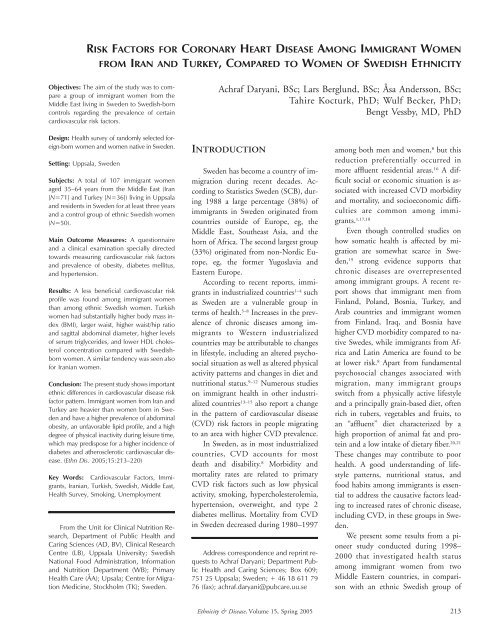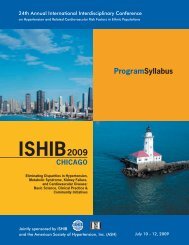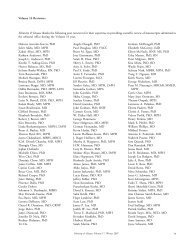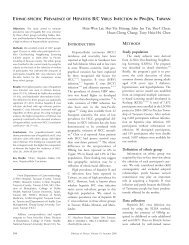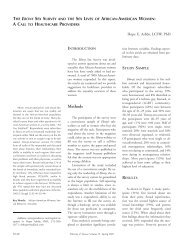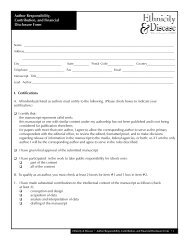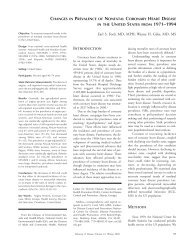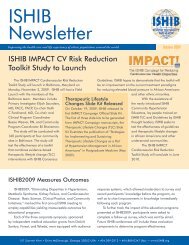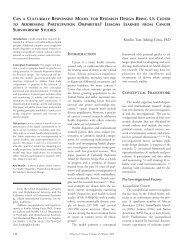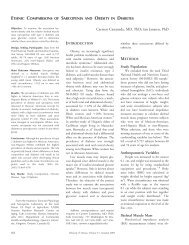Achraf Daryani, BSc; Lars Berglund, BSc; A˚sa Andersson, BSc ...
Achraf Daryani, BSc; Lars Berglund, BSc; A˚sa Andersson, BSc ...
Achraf Daryani, BSc; Lars Berglund, BSc; A˚sa Andersson, BSc ...
You also want an ePaper? Increase the reach of your titles
YUMPU automatically turns print PDFs into web optimized ePapers that Google loves.
RISK FACTORS FOR CORONARY HEART DISEASE AMONG IMMIGRANT WOMEN<br />
FROM IRAN AND TURKEY, COMPARED TO WOMEN OF SWEDISH ETHNICITY<br />
Objectives: The aim of the study was to compare<br />
a group of immigrant women from the<br />
Middle East living in Sweden to Swedish-born<br />
controls regarding the prevalence of certain<br />
cardiovascular risk factors.<br />
Design: Health survey of randomly selected foreign-born<br />
women and women native in Sweden.<br />
Setting: Uppsala, Sweden<br />
Subjects: A total of 107 immigrant women<br />
aged 35–64 years from the Middle East (Iran<br />
[N71] and Turkey [N36]) living in Uppsala<br />
and residents in Sweden for at least three years<br />
and a control group of ethnic Swedish women<br />
(N50).<br />
Main Outcome Measures: A questionnaire<br />
and a clinical examination specially directed<br />
towards measuring cardiovascular risk factors<br />
and prevalence of obesity, diabetes mellitus,<br />
and hypertension.<br />
Results: A less beneficial cardiovascular risk<br />
profile was found among immigrant women<br />
than among ethnic Swedish women. Turkish<br />
women had substantially higher body mass index<br />
(BMI), larger waist, higher waist/hip ratio<br />
and sagittal abdominal diameter, higher levels<br />
of serum triglycerides, and lower HDL cholesterol<br />
concentration compared with Swedishborn<br />
women. A similar tendency was seen also<br />
for Iranian women.<br />
Conclusion: The present study shows important<br />
ethnic differences in cardiovascular disease risk<br />
factor pattern. Immigrant women from Iran and<br />
Turkey are heavier than women born in Sweden<br />
and have a higher prevalence of abdominal<br />
obesity, an unfavorable lipid profile, and a high<br />
degree of physical inactivity during leisure time,<br />
which may predispose for a higher incidence of<br />
diabetes and atherosclerotic cardiovascular disease.<br />
(Ethn Dis. 2005;15:213–220)<br />
Key Words: Cardiovascular Factors, Immigrants,<br />
Iranian, Turkish, Swedish, Middle East,<br />
Health Survey, Smoking, Unemployment<br />
From the Unit for Clinical Nutrition Research,<br />
Department of Public Health and<br />
Caring Sciences (AD, BV), Clinical Research<br />
Centre (LB), Uppsala University; Swedish<br />
National Food Administration, Information<br />
and Nutrition Department (WB); Primary<br />
Health Care (A˚A); Upsala; Centre for Migration<br />
Medicine, Stockholm (TK); Sweden.<br />
<strong>Achraf</strong> <strong>Daryani</strong>, <strong>BSc</strong>; <strong>Lars</strong> <strong>Berglund</strong>, <strong>BSc</strong>; A˚ sa <strong>Andersson</strong>, <strong>BSc</strong>;<br />
Tahire Kocturk, PhD; Wulf Becker, PhD;<br />
Bengt Vessby, MD, PhD<br />
INTRODUCTION<br />
Sweden has become a country of immigration<br />
during recent decades. According<br />
to Statistics Sweden (SCB), during<br />
1988 a large percentage (38%) of<br />
immigrants in Sweden originated from<br />
countries outside of Europe, eg, the<br />
Middle East, Southeast Asia, and the<br />
horn of Africa. The second largest group<br />
(33%) originated from non-Nordic Europe,<br />
eg, the former Yugoslavia and<br />
Eastern Europe.<br />
According to recent reports, immigrants<br />
in industrialized countries 1–4 such<br />
as Sweden are a vulnerable group in<br />
terms of health. 5–8 Increases in the prevalence<br />
of chronic diseases among immigrants<br />
to Western industrialized<br />
countries may be attributable to changes<br />
in lifestyle, including an altered psychosocial<br />
situation as well as altered physical<br />
activity patterns and changes in diet and<br />
nutritional status. 9–12 Numerous studies<br />
on immigrant health in other industrialized<br />
countries 13–15 also report a change<br />
in the pattern of cardiovascular disease<br />
(CVD) risk factors in people migrating<br />
to an area with higher CVD prevalence.<br />
In Sweden, as in most industrialized<br />
countries, CVD accounts for most<br />
death and disability. 8 Morbidity and<br />
mortality rates are related to primary<br />
CVD risk factors such as low physical<br />
activity, smoking, hypercholesterolemia,<br />
hypertension, overweight, and type 2<br />
diabetes mellitus. Mortality from CVD<br />
in Sweden decreased during 1980–1997<br />
Address correspondence and reprint requests<br />
to <strong>Achraf</strong> <strong>Daryani</strong>; Department Public<br />
Health and Caring Sciences; Box 609;<br />
751 25 Uppsala; Sweden; 46 18 611 79<br />
76 (fax); achraf.daryani@pubcare.uu.se<br />
Ethnicity & Disease, Volume 15, Spring 2005<br />
among both men and women, 8 but this<br />
reduction preferentially occurred in<br />
more affluent residential areas. 16 A difficult<br />
social or economic situation is associated<br />
with increased CVD morbidity<br />
and mortality, and socioeconomic difficulties<br />
are common among immigrants.<br />
1,17,18<br />
Even though controlled studies on<br />
how somatic health is affected by migration<br />
are somewhat scarce in Sweden,<br />
19 strong evidence supports that<br />
chronic diseases are overrepresented<br />
among immigrant groups. A recent report<br />
shows that immigrant men from<br />
Finland, Poland, Bosnia, Turkey, and<br />
Arab countries and immigrant women<br />
from Finland, Iraq, and Bosnia have<br />
higher CVD morbidity compared to native<br />
Swedes, while immigrants from Africa<br />
and Latin America are found to be<br />
at lower risk. 8 Apart from fundamental<br />
psychosocial changes associated with<br />
migration, many immigrant groups<br />
switch from a physically active lifestyle<br />
and a principally grain-based diet, often<br />
rich in tubers, vegetables and fruits, to<br />
an ‘‘affluent’’ diet characterized by a<br />
high proportion of animal fat and protein<br />
and a low intake of dietary fiber. 20,21<br />
These changes may contribute to poor<br />
health. A good understanding of lifestyle<br />
patterns, nutritional status, and<br />
food habits among immigrants is essential<br />
to address the causative factors leading<br />
to increased rates of chronic disease,<br />
including CVD, in these groups in Sweden.<br />
We present some results from a pioneer<br />
study conducted during 1998–<br />
2000 that investigated health status<br />
among immigrant women from two<br />
Middle Eastern countries, in comparison<br />
with an ethnic Swedish group of<br />
213
WOMEN AND CORONARY HEART DISEASE RISK - <strong>Daryani</strong> et al<br />
Even though controlled<br />
studies on how somatic<br />
health is affected by<br />
migration are somewhat<br />
scarce in Sweden, 19 strong<br />
evidence supports that<br />
chronic diseases are<br />
overrepresented among<br />
immigrant groups.<br />
women residing in the county of Uppsala.<br />
The main purpose of this study was<br />
to test whether women born in the<br />
Middle East who were first-generation<br />
immigrants in Sweden were likelier to<br />
display a higher prevalence of CVD risk<br />
factors than native Swedish women.<br />
MATERIAL AND METHODS<br />
The study included first-generation<br />
immigrant women born in a Middle<br />
Eastern country between the years<br />
1933–1962, residing in the municipality<br />
of Uppsala for at least 3 years.<br />
As of January 1, 1996, a total of<br />
1,086 women aged 35–64 years from<br />
the Middle East were living in Uppsala,<br />
most (80%) of whom had emigrated either<br />
from Iran or Turkey. We therefore<br />
decided to concentrate on women born<br />
in these two countries.<br />
We sought collaboration with SCB<br />
for drawing a random sample of 90<br />
women from each of these countries<br />
who fulfilled the above-mentioned criteria.<br />
A group of 90 women born in<br />
Sweden during the same time period residing<br />
in Uppsala was also selected at<br />
random.<br />
The sample, 180 immigrant women<br />
and 90 native controls, were initially<br />
contacted through the SCB with a letter<br />
of invitation describing the nature of<br />
the study and seeking their collaboration.<br />
Nonrespondents received two additional<br />
letters as reminders. Those who<br />
agreed to participate were approached<br />
by mail and telephone and asked to fill<br />
out a questionnaire and invited for a<br />
free health screening and clinical examination.<br />
The Questionnaire<br />
A self-administered questionnaire in<br />
the native language was completed at<br />
home and used to collect information<br />
regarding socioeconomic background,<br />
occupation, migration, health history,<br />
smoking, physical activity, and food<br />
habits.<br />
Health Screening<br />
Participants were screened at the<br />
Metabolic Research Unit of the Department<br />
of Geriatrics of Uppsala University.<br />
The examination was directed at<br />
measuring the prevalence of obesity, diabetes<br />
mellitus, hypertension, and a<br />
clustering of metabolic risk factors indicative<br />
of the metabolic syndrome. 22<br />
Clinical Examination<br />
The clinical examination with blood<br />
sampling was conducted in the morning<br />
between 07:15 and 09:00. Participants<br />
were instructed to fast for 12 h, restrain<br />
from smoking or snuff, and avoid alcohol<br />
and vigorous physical activity the<br />
day before the clinical examination.<br />
Anthropometric Variables<br />
Height was measured to nearest 0.5<br />
cm, and body weight was measured on<br />
a digital scale to the nearest 0.1 kg without<br />
shoes in light indoor clothing. Body<br />
mass index (BMI) was calculated as the<br />
ratio of body weight (kg) divided by<br />
height (m) squared. Waist and hip circumference<br />
were measured in a supine<br />
position. Waist circumference was measured<br />
midway between the lowest rib<br />
and the iliac crest, and hip circumference<br />
was measured at the widest part of<br />
the hip, so waist to hip ratio (WHR)<br />
could be calculated. The sagittal abdom-<br />
214 Ethnicity & Disease, Volume 15, Spring 2005<br />
inal diameter (SAD) was measured as<br />
the height of the stomach (cm) when<br />
lying on the back on a firm examination<br />
table with knees bent.<br />
Blood Pressure and Pulse Rate<br />
Blood pressure was measured in the<br />
right arm after the subject had been supine<br />
for 5 minutes, by indirect auscultation<br />
and with a mercury sphygmomanometer.<br />
Systolic and diastolic blood<br />
pressures were defined as Korotkoff<br />
phases 1 and 5, respectively. The pulse<br />
rate was recorded by palpating the radial<br />
pulse for 30 seconds before blood pressure<br />
measurement.<br />
Blood and Urine Samples<br />
Blood samples were drawn from an<br />
antecubital vein, and all serum and plasma<br />
samples were immediately chilled,<br />
kept on ice, centrifuged, and stored at<br />
70C until analyzed. The 24-hour<br />
urine sample was collected in a special<br />
aliquot cup (Diasho Co. Ltd., Osaka,<br />
Japan). In a cartridge at the bottom of<br />
the collection cup a small proportion<br />
(representative of and proportional to<br />
the whole urine volume) of the urine<br />
was sampled. The volume of the urine<br />
in the special cartridge was measured<br />
and noted. A representative sample from<br />
this cartridge was taken out with a pipette,<br />
frozen, and stored at 70C.<br />
Lipoproteins<br />
Lipoprotein composition in serum<br />
was determined. Total cholesterol and<br />
triglyceride levels in serum were assayed<br />
by enzymatic techniques by using a<br />
Monarch apparatus (Instrumentation<br />
Laboratories; Lexington, Mass.). High<br />
density lipoproteins (HDLs) were isolated<br />
by centrifugation and precipitation<br />
with magnesium chloride/phosphotungstate.<br />
23 Low density lipoprotein (LDL)<br />
cholesterol was calculated according to<br />
the formula of Friedewald: LDLserum<br />
cholesterol - HDL cholesterol - (0.45 <br />
serum triglycerides).<br />
The concentrations of serum apolipoproteins<br />
(apo) A-1 and B were deter-
mined by immunoturbidimetry in a<br />
Monarch apparatus. Lipoprotein (a) was<br />
measured by a apo (a) radioimmmmunoassay<br />
method (Pharmacia, Uppsala,<br />
Sweden). The concentration is expressed<br />
in U/L. According to the manufacturer,<br />
one U of apo (a) is approximately equal<br />
to 0.7 mg LP(a). Serum free fatty acids<br />
(FFA) were determined by an enzymatic-colorimetric<br />
method using a commercial<br />
kit (Wako Chemicals GmbH,<br />
Neuss, Germany) applied for a Monarch<br />
centrifugal analyzer.<br />
Glucose and Insulin<br />
Blood glucose concentrations were<br />
measured by the glucose oxidase method.<br />
24 Serum insulin was analyzed using<br />
an enzyme immunoassay ELISA-kit<br />
(Mercodia AB, Uppsala, Sweden) in a<br />
Coda Automated EIA analyzer (Bio-Rad<br />
laboratories AB, Scandinavia).<br />
Dietary Intake<br />
Dietary intake was assessed through<br />
four repeated 24-hr food intake records.<br />
This part of the study will be presented<br />
in a separate paper.<br />
STATISTICAL ANALYSES<br />
The statistical analyses were performed<br />
by using SAS for Windows (SAS<br />
Insitute, Cary, NC, USA). The basic<br />
statistical analysis included comparisons<br />
between the two groups of immigrant<br />
women and the group of Swedish-born<br />
women. For continuous variables an<br />
analysis of variance model was performed.<br />
When the overall F-test of all<br />
three groups was statistically significant<br />
at the 5% level, the three pairwise comparisons<br />
were performed. For variables<br />
with skewed distributions (Sharpiro<br />
Wilk’s W-test0.95), a logarithmic<br />
transformation was made before the statistical<br />
analysis. The results are presented<br />
as means standard deviation (SD).<br />
For categorical variables the three<br />
groups were compared by using Fisher’s<br />
Exact Test. All tests were two-sided, and<br />
WOMEN AND CORONARY HEART DISEASE RISK - <strong>Daryani</strong> et al<br />
a P value.05 was regarded as statistically<br />
significant. However, as several<br />
comparisons were performed between<br />
the three groups, the importance of the<br />
weakest statistical differences should be<br />
interpreted with care to avoid a type 1<br />
error.<br />
ETHICAL ASPECTS<br />
The Ethical Committee of the Medical<br />
Faculty of Uppsala University, Sweden,<br />
approved the study. All subjects<br />
gave informed consent before entering<br />
the study.<br />
RESULTS<br />
Response Rate<br />
One hundred fifty-seven women (71<br />
from Iran, 36 from Turkey, and 50<br />
Swedish-born) agreed to participate and<br />
completed the screening process. Response<br />
rate was low (40%) among Turkish<br />
women, intermediate (54%) among<br />
Swedish women, and highest (79%)<br />
among Iranian women.<br />
Education and Some Lifestyle<br />
Factors<br />
Table 1 shows the level of education<br />
and other lifestyle factors of importance<br />
for risk to develop CVD. The mean age<br />
was significantly higher among ethnic<br />
Swedish women than among immigrants<br />
(Table 2). Therefore, risk factor<br />
levels were adjusted for age when compared<br />
between immigrants and Swedish<br />
women when presented below.<br />
Turkish women had the lowest level<br />
of educational attainment. Further, unemployment<br />
was significantly higher<br />
among Turkish women compared with<br />
native Swedes. Smoking rates did not<br />
differ among groups, but the number of<br />
ex-smokers was significantly higher<br />
among Swedish women. Iranian women<br />
reported significantly less physical activity<br />
during leisure time compared with<br />
Swedish-born women, while heavy occupational<br />
work was more common<br />
Ethnicity & Disease, Volume 15, Spring 2005<br />
among Turkish women than among the<br />
two other groups, although not significantly<br />
so.<br />
Age and Anthropometric<br />
Findings<br />
Table 2 shows mean values for age<br />
and anthropometric measurements in<br />
the two groups of immigrant women<br />
and in the control group. BMI and<br />
SAD were significantly higher in women<br />
from Turkey than in those from Iran.<br />
Swedish-born women had a significantly<br />
lower BMI and SAD than the two other<br />
groups. Waist circumference was significantly<br />
higher in Turkish women than<br />
in women from Iran and Sweden, respectively.<br />
Serum Lipoprotein<br />
Concentrations, Glucose,<br />
Insulin, and Blood Pressure<br />
Lipid and lipoprotein data, glucose,<br />
insulin, and blood pressure are presented<br />
in Table 3. While differences in total<br />
blood cholesterol were not significant,<br />
both Turkish and Iranian women had<br />
significantly higher triglyceride levels<br />
than native Swedes. However, Swedishborn<br />
women had significantly higher<br />
HDL cholesterol levels than the two<br />
other groups. Low-density lipoprotein<br />
(LDL) cholesterol was not significantly<br />
different between the three groups.<br />
The LDL/HDL ratio was significantly<br />
higher in Iranian women than<br />
Swedish-born women. Insulin levels<br />
were significantly higher in Turkish<br />
women than Swedish-born women. No<br />
significant differences were found<br />
among the women regarding glucose<br />
and blood pressure levels.<br />
Disorders Associated with the<br />
Metabolic Syndrome<br />
Table 4 shows the proportion of individuals<br />
with disorders associated with<br />
the metabolic syndrome. Turkish women<br />
had a significantly higher prevalence<br />
of metabolic syndrome indicators than<br />
Swedish-born women, illustrated by a<br />
higher prevalence of obesity, abdominal<br />
215
WOMEN AND CORONARY HEART DISEASE RISK - <strong>Daryani</strong> et al<br />
Table 1. Percentage of women of Iranian, Turkish, and Swedish origin reporting education, unemployment, smoking, and<br />
physical activity<br />
Background<br />
Iranian <br />
N71<br />
Turkish <br />
N36<br />
Swedish <br />
N50<br />
216 Ethnicity & Disease, Volume 15, Spring 2005<br />
P Value<br />
(a)<br />
P Value<br />
(b)<br />
P Value<br />
(c)<br />
Education (illiteracy) % 0 26 — — .0001 —<br />
Low education (0–6 years) % 11 60 — — .0001 —<br />
Unemployment % 52 69 20 .0006 ns .0001<br />
Smokers % 21 17 10 ns ns ns<br />
Ex-smokers % 27 43 55 .0046 ns ns<br />
Low physical activity during<br />
leisure time % 49 34 18 .0009 ns ns<br />
High and moderate physical<br />
activity at work % 14 28 22 ns ns ns<br />
ns non significant; a significant difference (P.05): Iranian vs Swedish women; b significant difference: Iranian vs Turkish women; c significant difference: Turkish<br />
vs Swedish women. P adjusted for age.<br />
obesity, low HDL cholesterol, and fasting<br />
glucose. A similar tendency, but<br />
only significant for obesity and low<br />
HDL cholesterol, was found for Iranian<br />
women.<br />
DISCUSSION<br />
The aim of the study was to compare<br />
a group of immigrant women from<br />
the Middle East living in Uppsala with<br />
ethnic Swedish controls regarding the<br />
prevalence of certain nutrition-related<br />
risk factors for chronic conditions such<br />
as obesity, type 2 diabetes, and the metabolic<br />
syndrome. The most important<br />
finding was that immigrant women had<br />
a higher prevalence of risk factors for<br />
CVD.<br />
Participation was lowest among<br />
Table 2. Age and anthropometric characteristics for each group<br />
Age (year)<br />
Height (cm)<br />
Weight (Kg)<br />
BMI (Kg/m 2 )<br />
SAD (cm)<br />
Waist (cm)<br />
WHR<br />
Iranian <br />
N71<br />
47.1 8.1<br />
159.5 5.28<br />
66.5 10.91<br />
26.3 4.59<br />
21.9 2.74<br />
81.9 10.19<br />
0.80 0.05<br />
Turkish women (40%) and highest<br />
among Iranian women (79%). Divergent<br />
response rates between these two<br />
immigrant groups partly reflects the fact<br />
that these two populations differ in several<br />
aspects, eg, origin (urban-rural), education,<br />
and cultural and socioeconomic<br />
background in the home country.<br />
Many women from Iran in this study<br />
had emigrated from a large city, where<br />
access to health care is readily available.<br />
On the other hand, many of the women<br />
from Turkey were of Kurdish ethnicity<br />
and had emigrated from small, rural<br />
communities, usually with a poor standard<br />
of living. This discrepancy is also<br />
evident in the level of education and<br />
Swedish language skills in the two immigrant<br />
groups. Inability to speak the<br />
local language complicates integration<br />
to the host society. These groups of<br />
Turkish <br />
N36<br />
45.7 7.3<br />
157.2 6.65<br />
70.2 10.31<br />
28.4 4.09<br />
23.3 2.43<br />
86.3 8.61<br />
0.83 0.06<br />
Swedish <br />
N50<br />
51.1 9.0<br />
165.3 5.88<br />
67.6 9.65<br />
24.7 3.35<br />
21.5 2.32<br />
80.3 9.20<br />
0.80 0.06<br />
women generally live isolated from the<br />
larger society and depend on family<br />
members to communicate. They are simultaneously<br />
exposed to negative influences<br />
in Swedish society with high unemployment<br />
and acculturative stress.<br />
The disadvantages of the exile situation<br />
may have been another factor influencing<br />
the low response rate among women<br />
born in Turkey.<br />
The low participation in this group<br />
may also suggest that the recruitment<br />
method used in this study was not optimal.<br />
A better method may have been<br />
to approach participants through their<br />
own organizations and offer oral, instead<br />
of written, information. Written<br />
information is not an ideal recruitment<br />
method in a group with high illiteracy<br />
and a low level of education.<br />
This study showed that immigrant<br />
P Value<br />
(a)<br />
.0101<br />
.0001<br />
ns<br />
.0025<br />
.0338<br />
ns<br />
ns<br />
P Value<br />
(b)<br />
ns<br />
.0205<br />
ns<br />
.0036<br />
.0016<br />
.0073<br />
.0045<br />
P Value<br />
(c)<br />
.0036<br />
.0001<br />
ns<br />
.0001<br />
.0001<br />
.0001<br />
.0035<br />
BMI body mass index; SAD sagittal abdominal diameter; WHR waist/hip ratio.<br />
Mean SD.<br />
ns non-significant; a significant difference (P.05): Iranian vs Swedish women; b significant difference: Iranian vs Turkish women; c significant difference: Turkish<br />
vs Swedish women. P adjusted for age.
Table 3. Blood lipid parameters, glucose, insulin and blood pressure for each group<br />
Chol (mmol/l)<br />
TG (mmol/l)<br />
LDL (mmol/l)<br />
HDL (mmol/l)<br />
LDL/HDL<br />
FFA (mmol/l)<br />
S-apo A-1 (g/l)<br />
S-apo B (g/l)<br />
Glucose (mmol/l)<br />
Insulin (mU/L)<br />
SBP (mm Hg)<br />
DBP (mm Hg)<br />
Iranian <br />
N71<br />
5.18 0.09<br />
1.39 0.61<br />
3.23 0.83<br />
1.32 0.33<br />
2.65 1.08<br />
0.41 0.17<br />
1.52 0.36<br />
1.02 0.32<br />
5.32 1.60<br />
8.19 5.13<br />
116.96 16.09<br />
71.34 9.67<br />
Turkish <br />
N36<br />
5.23 0.77<br />
1.37 0.52<br />
3.29 0.80<br />
1.33 0.32<br />
2.62 0.90<br />
0.45 0.18<br />
1.44 0.18<br />
0.95 0.20<br />
5.70 1.25<br />
9.39 3.98<br />
119.43 19.91<br />
72.46 11.61<br />
WOMEN AND CORONARY HEART DISEASE RISK - <strong>Daryani</strong> et al<br />
Swedish <br />
N50<br />
5.79 0.86<br />
0.96 0.52<br />
3.68 0.90<br />
1.68 0.38<br />
2.35 0.93<br />
0.48 0.28<br />
1.55 0.20<br />
0.95 0.22<br />
5.49 2.25<br />
7.29 5.02<br />
122.24 19.10<br />
73.50 8.80<br />
Ethnicity & Disease, Volume 15, Spring 2005<br />
P Value<br />
(a)<br />
ns<br />
.0001<br />
ns<br />
.0001<br />
.0234<br />
ns<br />
ns<br />
.0372<br />
ns<br />
ns<br />
ns<br />
ns<br />
P Value<br />
(b)<br />
ns<br />
ns<br />
ns<br />
ns<br />
ns<br />
ns<br />
ns<br />
ns<br />
ns<br />
ns<br />
ns<br />
ns<br />
P Value<br />
(c)<br />
ns<br />
.0003<br />
ns<br />
.0002<br />
ns<br />
ns<br />
ns<br />
ns<br />
ns<br />
.0207<br />
ns<br />
ns<br />
Chol serum cholesterol; TG triglycerides; LDL low-density lipoprotein cholesterol; HDL high-density lipoprotein cholesterol; FFA serum free fatty acids; S-apo<br />
serum apolipoproteins; SBP systolic blood pressure; DBP diastolic blood pressure. Mean SD.<br />
ns non-significant; a significant difference (P.05): Iranian vs Swedish women; b significant difference: Iranian vs Turkish women; c significant difference: Turkish<br />
vs Swedish women. P adjusted for age.<br />
women have a less beneficial cardiovascular<br />
risk profile than Swedish-born<br />
women. Women born in Turkey, most<br />
of whom were of Kurdish ethnicity, had<br />
substantially higher BMI, larger waist<br />
circumference, higher waist/hip ratio<br />
and SAD, higher levels of serum triglycerides,<br />
and lower HDL cholesterol<br />
concentrations compared to native<br />
Swedish women. The same tendency,<br />
but only significant for BMI, SAD, serum<br />
triglycerides, HDL cholesterol, and<br />
LDL/HDL ratio was seen for women<br />
born in Iran.<br />
Table 4. The proportion (%) of individuals with disorders associated with the metabolic syndrome for each group<br />
Iranian <br />
N71<br />
Several studies support an association<br />
between various anthropometric indices<br />
of obesity and diabetes, 25 as well<br />
as stroke, angina pectoris, and all-cause<br />
mortality. 26,27 Diabetes, elevated serum<br />
cholesterol levels, and hypertension were<br />
two to five times more prevalent among<br />
women with higher BMI. 27 Other studies<br />
based on large populations followed<br />
up over long periods have shown a relationship<br />
between BMI and mortality<br />
from all causes. 28,29 Data from the Framingham<br />
study showed that cardiovascular<br />
risk is closely linked to abdominal<br />
Turkish <br />
N36<br />
Swedish <br />
N50<br />
P Value<br />
(a)<br />
as well as general adiposity. 28,29 Both<br />
waist circumference and SAD, indicating<br />
increased abdominal adiposity, were<br />
higher in immigrant women than ethnic<br />
Swedish women.<br />
HDL cholesterol levels were significantly<br />
lower and triglyceride levels were<br />
significantly higher in the immigrant<br />
groups compared to the ethnic Swedes<br />
in this study. A 20-year follow-up of<br />
women in a prospective population<br />
study in Gothenburg, Sweden, showed<br />
that increased serum triglyceride concentrations<br />
and abdominal adiposity<br />
P Value<br />
(b)<br />
P Value<br />
(c)<br />
Obesity BMI 30 13 36 8 ns .001 .002<br />
Abdominal obesity waist<br />
girth 88 cm 20 43 18 ns .02 .02<br />
High cholesterol 6.5 mmol/l 13 6 18 ns ns ns<br />
Low HDL cholesterol 1.29<br />
mmol/l 50 60 22 .002 ns .0006<br />
High triglycerides 1.69<br />
mmol/l 25 20 12 ns ns ns<br />
High blood pressure 130/<br />
85 mm Hg 6 14 8 ns ns ns<br />
High fasting glucose 6.1<br />
mmol/l 4 19 13 ns .03 ns<br />
Metabolic syndrome* 3<br />
risk factors 13 30 10 ns .06 .04<br />
ns non significant; a significant difference (P.05): Iranian vs Swedish women; b significant difference: Iranian vs Turkish women; c significant difference: Turkish<br />
vs Swedish women.<br />
* The metabolic syndrome is defined as having three or more risk factors. 22<br />
217
WOMEN AND CORONARY HEART DISEASE RISK - <strong>Daryani</strong> et al<br />
The most important finding<br />
was that immigrant women<br />
had a higher prevalence of<br />
risk factors for CVD.<br />
were associated with sharply increased<br />
risks of death from myocardial infarction<br />
and from all causes. 30 However, despite<br />
higher body weight, blood pressures<br />
tended to be lower among immigrants<br />
than among ethnic Swedish<br />
women. A lower rate of hypertension in<br />
spite of a higher body weight was earlier<br />
reported 31 among immigrants from the<br />
Middle East, in contrast to several other<br />
immigrant studies. 32 Possible genetic<br />
factors or diverging dietary habits between<br />
the groups may explain this difference.<br />
Unemployment rates were similar in<br />
the two immigrant groups. Iranian<br />
women, in spite of higher education and<br />
socioeconomic status, cannot find jobs<br />
commensurate with their qualifications<br />
in Sweden. Unemployment has, in previous<br />
reports, been associated with increased<br />
levels of CVD risk factors 33 and<br />
cardiac mortality. 34,35<br />
The immigrant groups reported significantly<br />
less physical activity during<br />
leisure time. Obesity and high body<br />
weight are strongly related to a lack of<br />
physical activity in the adult population<br />
of the European union. 36 Low leisuretime<br />
physical activity is also strongly associated<br />
with low income and low educational<br />
attainment. 37 In the United<br />
States the percentage of physical inactivity<br />
during leisure time is high among<br />
women, the elderly, and Mexican Americans<br />
(both immigrants and non-immigrants).<br />
38 Asians living in Britain had<br />
higher waist/hip ratio, lower physical activity,<br />
and less favorable lipid levels,<br />
compared to Indians living in Asia. 14<br />
The risk of myocardial infarction<br />
among men that are not physically active<br />
during their leisure time is approx-<br />
imately double compared to physically<br />
active men. 37,39,40 However the effect of<br />
physical inactivity on risk for myocardial<br />
infarction does not seem to be quite<br />
as great among women as among<br />
men. 37,39<br />
Ethnic and lifestyle differences in<br />
risk factors for CVD are important to<br />
consider. Finnish immigrants, for instance,<br />
have an increased risk of hypertension<br />
and hypercholesterolemia compared<br />
with native Swedes, while Mediterranean<br />
men have an increased<br />
tendency to smoke and become overweight.<br />
31 A Swedish population-based<br />
study revealed that Bosnian refugee<br />
women aged 42–59 years had substantially<br />
higher levels of general and abdominal<br />
obesity, higher levels of serum<br />
triglycerides and lower levels of HDL<br />
cholesterol. 41 Our findings agree with<br />
this previous report.<br />
Strengths and Limitation of the<br />
Study<br />
In recent decades, large numbers of<br />
people have emigrated to Western European<br />
countries from the Near East<br />
(particularly Turkey) and the Middle<br />
East (particularly Iran, Iraq, Lebanon,<br />
and Palestine). Approximately 57% of<br />
immigrants from non-European countries<br />
in Sweden come from the Middle<br />
East, including Turkey.<br />
The culture, lifestyles, and dietary<br />
habits in this area of the world differ<br />
substantially from those in Sweden. An<br />
increasing body of epidemiologic evidence<br />
indicates a high prevalence of<br />
CVD in these groups. 8,17,27,31 However,<br />
the number of studies focusing on CVD<br />
risk factors at the level of the individual<br />
immigrant, particularly for women,<br />
from the Middle East in Europe are almost<br />
nonexistent. This type of microlevel<br />
information is needed for health<br />
workers in multicultural areas because it<br />
allows for culturally adjusted health care<br />
and planning of intervention programs<br />
targeting immigrants. The strength of<br />
this study is its focus on risk factors at<br />
the individual level. As such, this study<br />
218 Ethnicity & Disease, Volume 15, Spring 2005<br />
is one of the very few of this type in<br />
Sweden. The method of random sampling<br />
among the two largest immigrant<br />
groups from the Middle East in Uppsala<br />
gives the study a high degree of reliability.<br />
Results from these groups are<br />
confirmed by similar findings reported<br />
by other authors. 8,42,43<br />
The low response rate, particularly<br />
from women born in Turkey, can be interpreted<br />
as a limitation. An analysis of<br />
reasons for non-response was not possible<br />
because of lack of access to the addresses<br />
and other background data of<br />
non-responders. Despite this setback,<br />
the collected data can be considered<br />
fairly reliable because of the random selection<br />
procedure that used a common<br />
data-base covering all female immigrants<br />
from Turkey living in Uppsala. If we instead<br />
had attempted to reach this sample<br />
of women through more informal<br />
and oral channels, we would perhaps<br />
have recruited more subjects, but intergroup<br />
variations of risk factors would<br />
likely have been larger. We know from<br />
other studies that those who attend<br />
health checks are likely to have a healthier<br />
lifestyle than non-participants. 44<br />
CONCLUSION AND<br />
FUTURE<br />
RECOMMENDATIONS<br />
We show important ethnic differences<br />
in CVD risk factors in two groups<br />
of female immigrants from the Middle<br />
East. Immigrant women from Iran and<br />
Turkey are heavier with a higher prevalence<br />
of abdominal obesity and have an<br />
unfavorable lipid profile with high serum<br />
triglycerides, low HDL cholesterol,<br />
and a high degree of physical inactivity<br />
during leisure time.<br />
We hope that this research will contribute<br />
to efforts to prevent CVD<br />
among these immigrant groups. In Sweden,<br />
increasing emphasis is placed on<br />
primary health care in the prevention of<br />
disease. To optimize preventive efforts,<br />
we suggest that immigrant women rep-
esenting specific risk groups be provided<br />
with diverse counseling about physical<br />
activity, diet, and social support as<br />
a part of patient-education programs.<br />
To the most practical extent, preventive<br />
programs should be presented in the native<br />
language of the participants. Unfortunately,<br />
the scarcity of culturally adapted<br />
educational material is a problem in<br />
Sweden. Educational material currently<br />
in use in primary health care should be<br />
adapted, considering concepts, methods,<br />
and dietary practices that are of relevance<br />
for the immigrant culture in question.<br />
ACKNOWLEDGMENTS<br />
We express our gratitude to the subjects for<br />
devoted participation in the study. We are<br />
also grateful to all co-workers at the metabolic<br />
ward and laboratories at the unit of<br />
Clinical Research at the Departments of<br />
Public Health and Caring Sciences for their<br />
support. The Vardal Foundation and the<br />
Foundation for Geriatric Research supported<br />
this work.<br />
REFERENCES<br />
1. Winkleby MA, Kraemer HC, Ahn DK, Varady<br />
AN. Ethnic and socioeconomic differences<br />
in cardiovascular disease risk factors: findings<br />
for women from the Third National<br />
Health and Nutrition Examination Survey,<br />
1988–1994. JAMA. 1998;280(4):356–362.<br />
2. Bongard S, Pogge SF, Arslaner H, Rohrmann<br />
S, Hodapp V. Acculturation and cardiovascular<br />
reactivity of second-generation Turkish<br />
migrants in Germany. J Psychosom Res. 2002;<br />
53(3):795–803.<br />
3. Sundquist J, Winkleby MA, Pudaric S. Cardiovascular<br />
disease risk factors among older<br />
Black, Mexican-American, and White women<br />
and men: an analysis of NHANES III, 1988–<br />
1994. Third National Health and Nutrition<br />
Examination Survey. J Am Geriatr Soc. 2001;<br />
49(2):109–116.<br />
4. Popkin BM, Udry JR. Adolescent obesity increases<br />
significantly in second and third generation<br />
US immigrants: the National Longitudinal<br />
Study of Adolescent Health. J Nutr.<br />
1998;128(4):701–706.<br />
5. Sundquist J, Johansson SE. The influence of<br />
country of birth on mortality from all causes<br />
and cardiovascular disease in Sweden, 1979–<br />
1993. Int J Epidemiol. 1997;26(2):279–287.<br />
6. Pudaric S, Sundquist J, Johansson SE. Major<br />
risk factors for cardiovascular disease in elderly<br />
migrants in Sweden. Ethn Health. 2000;<br />
5(2):137–150.<br />
WOMEN AND CORONARY HEART DISEASE RISK - <strong>Daryani</strong> et al<br />
7. Dotevall A, Rosengren A, Lappas G, Wilhelmsen<br />
L. Does immigration contribute to<br />
decreasing CHD incidence? Coronary risk<br />
factors among immigrants in Goteborg, Sweden.<br />
J Intern Med. 2000;247(3):331–339.<br />
8. Gadd M, Johansson SE, Sundquist J, Wandell<br />
P. Morbidity in cardiovascular diseases in immigrants<br />
in Sweden. J Intern Med. 2003;<br />
254(3):236–243.<br />
9. Kudo Y, Falciglia GA, Couch SC. Evolution<br />
of meal patterns and food choices of Japanese-<br />
American females born in the United States.<br />
Eur J Clin Nutr. 2000;54(8):665–670.<br />
10. Lee SK, Sobal J, Frongillo EA Jr. Acculturation<br />
and dietary practices among Korean<br />
Americans. J Am Diet Assoc. 1999;99(9):<br />
1084–1089.<br />
11. Pan YL, Dixon Z, Himburg S, Huffman F.<br />
Asian students change their eating patterns after<br />
living in the United States. J Am Diet Assoc.<br />
1999;99(1):54–57.<br />
12. Papadaki A, Scott JA. The impact on eating<br />
habits of temporary translocation from a<br />
Mediterranean to a Northern European environment.<br />
Eur J Clin Nutr. 2002;56(5):455–<br />
461.<br />
13. He J, Tell GS, Tang YC, Mo PS, He GQ.<br />
Effect of migration on blood pressure; The Yi<br />
people study. Epidemiology. 1991;2(suppl 2):<br />
88–97.<br />
14. Dhawn J, Bary C, Warburton R, Ghambhir<br />
DS, Morris J. Insulin resistance, high prevalance<br />
of diabetes, and cardiovascular risk in<br />
immigrant Asians. Genetic or environmental<br />
effect. Br Heart J. 1994;72:413–421.<br />
15. Hicks LS, Fairchild DG, Cook EF, Ayanian<br />
JZ. Association of region of residence and immigrant<br />
status with hypertension, renal failure,<br />
cardiovascular disease, and stroke among<br />
African-American participants in the third<br />
National Health and Nutrition Examination<br />
Survey (NHANES III). Ethn Dis. 2003;13(3):<br />
316–323.<br />
16. Malmstrom M, Sundquist J, Bajekal M, Johansson<br />
SE. Ten-year trends in all-cause mortality<br />
and coronary heart disease mortality in<br />
socio-economically diverse neighborhoods.<br />
Public Health. 1999;113(6):279–284.<br />
17. Sundquist J, Johansson SE. The influence of<br />
socioeconomic status, ethnicity, and lifestyle<br />
on body mass index in a longitudinal study.<br />
Int J Epidemiol. 1998;27(1):57–63.<br />
18. Lizarzaburu JL, Palinkas LA. Immigration, acculturation,<br />
and risk factors for obesity and cardiovascular<br />
disease: a comparison between Latinos<br />
of Peruvian descent in Peru and in the<br />
United States. Ethn Dis. 2002;12(3):342–352.<br />
19. Hjern A. Migrationsmedisinsk forskning. En<br />
översikt. Migration medicine research. A review<br />
(in Swedish). Sweden Medical Research<br />
Council. MFR. 1995.<br />
20. Kockturk T, Bruce A˚ . Human migration and<br />
nutrition. An överview. Scand J Nutr. 1996;<br />
40(2[suppl 31]):81–83.<br />
21. World Health Organization. Diet, nutrition,<br />
Ethnicity & Disease, Volume 15, Spring 2005<br />
and the prevention of chronic diseases. Report<br />
of a joint WHO/FAO Consultation.<br />
World Health Organ Tech Rep Ser. 2003;916.<br />
22. Executive summary of the third report of The<br />
National Cholesterol Education Program<br />
(NCEP) Expert Panel on Detection, Evaluation,<br />
and Treatment of High Blood Cholesterol<br />
in Adults (Adult Treatment Panel III).<br />
JAMA. 2001;285(19):2486–2497.<br />
23. Seigler L, Wu WT. Separation of serum highdensity<br />
lipoprotein for cholesterol determination:<br />
ultracentrifugation vs precipitation<br />
with sodium phosphotungstate and magnesium<br />
chloride. Clin Chem. 1981;27:838–841.<br />
24. Hjelm M. A methodological study of the enzymatic<br />
determination of glucose in blood.<br />
Scand J Clin Lab Invest. 1963;15:415–428.<br />
25. Lapidus L, Bengtsson C, <strong>Lars</strong>son B, Pennert<br />
K, Rybo E, Sjostrom L. Distribution of adipose<br />
tissue and risk of cardiovascular disease<br />
and death: a 12 year follow up of participants<br />
in the population study of women in Gothenburg,<br />
Sweden. BMJ. 1984;289(6454):<br />
1257–1261.<br />
26. <strong>Lars</strong>son B, Svardsudd K, Welin L, Wilhelmsen<br />
L, Bjorntorp P, Tibblin G. Abdominal adipose<br />
tissue distribution, obesity, and risk of<br />
cardiovascular disease and death: 13 year follow<br />
up of participants in the study of men<br />
born in 1913. BMJ. 1984;288(6428):1401–<br />
1404.<br />
27. Manson JE, Colditz GA, Stampfer MJ, et al.<br />
A prospective study of obesity and risk of coronary<br />
heart disease in women. N Engl J Med.<br />
1990;322(13):882–889.<br />
28. Rissanen A, Heliovaara M, Knekt P, Aromaa<br />
A, Reunanen A, Maatela J. Weight and mortality<br />
in Finnish men. J Clin Epidemiol. 1989;<br />
42(8):781–789.<br />
29. Sundquist J, Rosén U, Lindén ABS. The influence<br />
of social and ethnic segmentation on<br />
consultation in primary health care. Scand J<br />
Soc Welfare. 1994;3:19–23.<br />
30. Bengtsson C, Bjorkelund C, Lapidus L, Lissner<br />
L. Associations of serum lipid concentrations<br />
and obesity with mortality in women:<br />
20 year follow up of participants in prospective<br />
population study in Gothenburg, Sweden.<br />
BMJ. 1993;307(6916):1385–1388.<br />
31. Tomson Y, Aberg H. Risk factors for cardiovascular<br />
disease–a comparison between<br />
Swedes and immigrants. Scand J Prim Health<br />
Care. 1994;12(3):147–154.<br />
32. Salmond CE, Prior IA, Wessen AF. Blood<br />
pressure patterns and migration: a 14-year cohort<br />
study of adult Tokelauans. Am J Epidemiol.<br />
1989;130(1):37–52.<br />
33. Janlert U, Asplund K, Weinehall L. Unemployment<br />
and cardiovascular risk indicators.<br />
Data from the MONICA survey in northern<br />
Sweden. Scand J Soc Med. 1992;20(1):14–18.<br />
34. Martikainen PT. Unemployment and mortality<br />
among Finnish men, 1981–1985. BMJ.<br />
1990;301:407–411.<br />
35. Crombie IK, Kenicer MB, Smith WC, Tun-<br />
219
WOMEN AND CORONARY HEART DISEASE RISK - <strong>Daryani</strong> et al<br />
stall-Pedoe HD. Unemployment, socioenvironmental<br />
factors, and coronary heart disease<br />
in Scotland. Br Heart J. 1989;61(2):172–177.<br />
36. Martinez-Gonzalez MA, Martinez JA, Hu FB,<br />
Gibney MJ, Kearney J. Physical inactivity,<br />
sedentary lifestyle, and obesity in the European<br />
Union. Int J Obes Relat Metab Disord.<br />
1999;23(11):1192–1201.<br />
37. Johansson S, Rosengren A, Tsipogianni A, Ulvenstam<br />
G, Wiklund I, Wilhelmsen L. Physical<br />
inactivity as a risk factor for primary and<br />
secondary coronary events in Goteborg, Sweden.<br />
EurHeartJ.1988;9(suppl L):8–19.<br />
38. Crespo CJ, Keteyian SJ, Heath GW, Sempos<br />
CT. Leisure-time physical activity among US<br />
adults. Results from the Third National<br />
Health and Nutrition Examination Survey.<br />
Arch Intern Med. 1996;156(1):93–98.<br />
39. Salonen JT, Slater JS, Tuomilehto J, Raura-<br />
maa R. Leisure-time and occupational physical<br />
activity: risk of death from ischemic heart<br />
disease. Am J Epidemiol. 1988;127(1):87–94.<br />
40. Kannel WB, Sorlie P. Some health benefits of<br />
physical activity. The Framingham Study.<br />
Arch Intern Med. 1979;139(8):857–861.<br />
41. Sundquist J, Cmelic-Eng M, Johansson SE.<br />
Body mass index and distribution of body fat<br />
in female Bosnian refugees—a study in primary<br />
health care. Public Health. 1999;113(2):<br />
89–93.<br />
42. Wandell PE, Hjorleifsdottir Steiner K, Johansson<br />
SE. Diabetes mellitus in Turkish immigrants<br />
in Sweden. Diabetes Metab. 2003;<br />
29(4, pt 1):435–439.<br />
43. Wandell PE, Ponzer S, Johansson E, Sundquist<br />
K, Sundquist J. Country of Birth and Body<br />
Mass Index: A National Study of 2000 Immigrants<br />
in Sweden. Eur J Epidemiol. 2004;<br />
19(11):1005–1010.<br />
220 Ethnicity & Disease, Volume 15, Spring 2005<br />
44. Pill R, French J, Harding K, Stott N. Invitation<br />
to attend a health check in general<br />
practice setting: comparison of attenders and<br />
non-attenders. J R Coll Gen Pract. 1988;38:<br />
53–56.<br />
AUTHOR CONTRIBUTIONS<br />
Design and concept of study: <strong>Daryani</strong>, Vessby,<br />
Becker, Kockturk, <strong>Berglund</strong><br />
Acquisition of data: <strong>Daryani</strong>, Vessby, Becker,<br />
Kockturk, <strong>Andersson</strong><br />
Data analysis and interpretation: <strong>Daryani</strong>,<br />
<strong>Berglund</strong>, Vessby, Becker<br />
Manuscript draft: <strong>Daryani</strong>, Vessby, Becker,<br />
<strong>Berglund</strong><br />
Statistical expertise: <strong>Berglund</strong><br />
Acquisition of funding: Vessby<br />
Administrative, technical, or material assistance:<br />
<strong>Daryani</strong>, Vessby


